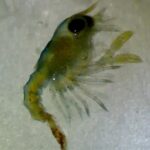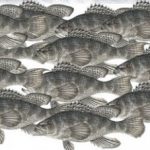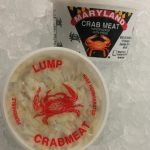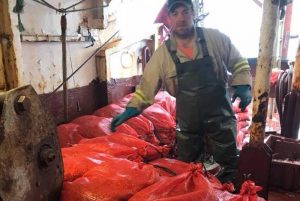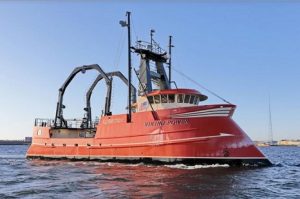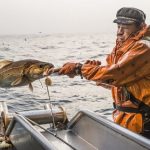U.S. Fish and Wildlife Service Strategy to Reintroduce Sea Otters is Flawed
August 10, 2022
For information, contact:
Dave Rudie, California Sea Urchin Commission, 619-572-2738, [email protected]
Mike Conroy, Pacific Coast Federation of Fishermen’s Associations, 562-761-7176, [email protected]
David Goldenberg, California Sea Urchin Commission, 916-933-7054, [email protected]
Lori Steele, West Coast Seafood Processors Association: 503-227-5076, [email protected]
U.S. Fish and Wildlife Service Strategy to Reintroduce Sea Otters is Flawed
The USFWS study fails to estimate costs to taxpayers; impacts to key local fisheries such as Dungeness crab and sea urchin; neglects to fully examine the impacts to local port and harbor activities and fishing communities and fails to directly clarify to impacted Tribal Nations that no ceremonial and subsistence uses – or control of otter populations negatively impacting other important Tribal resources – are permitted under current Federal law. For Oregon and California coastal communities dependent on Dungeness crab, sea urchin, and other shellfish, reintroducing sea otters in an area where they have been absent for more than 100 years will spell big trouble. Yet, a recent report from the U.S. Fish and Wildlife Service (USFWS) concludes it is “feasible” to reintroduce them to Southern Oregon and Northern California. In June 2022, the USFWS report, Feasibility Assessment: Sea Otter Reintroduction to the Pacific Coast, was released in response to a largely-unvetted Congressional mandate. In this report, the Agency lays out the potential benefits of reintroducing sea otters to new areas of the West Coast. It identifies some – but not all – significant areas of concern.
When plentiful, shellfish and crabs account for a most of a sea otter’s diet. Their voracious feeding activity, especially related to the almost certain impacts to the West Coast heritage Dungeness crab fishery and sea urchin harvests, alarms West Coast fishermen and processors. Otters eat 23% to 33% of their body weight daily. Just 169 otters weighing an average of 50 pounds each, feeding full time on urchins, would consume an amount equal to the entire annual commercial catch, making a commercial fishery not viable. Dungeness crabs are caught near small ports from Oregon to Central California, and the sea urchin fishery operates in Oregon and California.
The USFWS report indicates the coastwide population and corresponding harvest of Dungeness crab “would not likely be significantly affected.” However, there is ample evidence showing that reintroducing sea otters will significantly impact Dungeness crab and other fisheries, West Coast ports,
and other industries, California Sea Urchin Commission Chairman Dave Rudie says.
“We’ve seen it happen already in California, Washington and Alaska,” Rudie says. “The fishing industry in California is losing $20 million per year from the loss at San Nicolas Island due to sea otters feeding on shellfish.”
The USFWS promised to remove the marauding otters from San Nicolas Island if the translocation program proved to be a failure, but the Agency failed to fulfill its promise, even after it declared its own program a complete failure. The USFWS has repeatedly proven it cannot be trusted to implement sustainable sea otter management. As a result, the impacts of sea otter reintroduction on fisheries and fishing communities along the Pacific Coast will be much more significant and widespread than the Agency can predict.
“This is unacceptable,” West Coast Seafood Processors Association Executive Director Lori Steele says. “Our coastal communities rely on the Dungeness crab and sea urchin fisheries to bolster seasonal income and work forces sustaining other, year-round fisheries.”
Steele compared the USFWS efforts to other Department of Interior (DOI) plans relating to the ocean environment.
“This is not all that different from the Department of Interior’s meager efforts to mitigate impacts of offshore wind energy on fisheries and fishing communities,” Steele adds. “This time, we see another DOI Agency conducting limited quantitative analysis to determine it is feasible to reintroduce this shellfish predator into the ecosystem.”
“Our ports, our charter, sport and commercial fisheries, our livelihoods depend on robust fisheries management by State and Federal Agencies. Introducing sea otters, especially as they would be protected under the Endangered Species and Marine Mammal Protection Acts, creates another layer of fisheries management problems,” Pacific Coast Federation of Fishermen’s Associations Executive Director Mike Conroy says. “As we stated, our local ecosystems have evolved without sea otter presence. Careful thoughts and planning are necessary to prevent dire impacts to commercial and
recreational fisheries.”
The USFWS claims sea otters help fix the climate crisis by reducing sea urchin population impacts on kelp forests off the California Coast, but this is largely speculative and based on limited data. Kelp cycles are driven primarily by water temperature. Before the last warm water cycle, kelp was thriving inside and outside the sea otter range; now, both areas have problems with kelp and sea urchins. Research suggests kelp is only a temporary carbon sink, as most of it is consumed or decomposes, and the carbon dioxide is released.
The actual costs of sea otter reintroduction are not identified in the recent USFWS report but noted and delayed for future consideration. In addition to harming fishermen, markets and restaurants, sea otter reintroduction seriously threatens our local and national food security by reducing the supply of healthy, sustainable seafood from the West Coast. There are also significant impacts to maintenance of port and harbor infrastructure and restrictions on commercial vessel and pleasure boating activities to consider.
“We’re glad this report doesn’t green-light sea otter reintroduction or translocation right away. At the very least, the USFWS understands a lot more work needs to be done,” California Sea Urchin Commission Executive Director David Goldenberg says. “The Agency has done nothing to prove they will avoid past mistakes. Our experience with the translocation of sea otters in Southern California in 1986 resulted in mismanagement and broken promises made to Congress, the sea urchin industry and the public. It was obvious they failed to consider the ramifications of reintroduction and the economic loss of locally harvested seafood for fishermen, coastal communities and seafood consumers.”
WCSPA Director Steele adds, “Congress triggered this issue with no discussion or debate in the form of a provision that was quietly added to an appropriations bill at the end of 2021. We are hopeful we do not see a repeat of this in 2022.”
In August 2021, 24 port, fishing and seafood organizations in Washington, Oregon, and California, sent a detailed letter to the USFWS requesting that a specific list of issues be clearly addressed in the cost and feasibility study. Unfortunately, many questions remain unanswered.
For more Information, visit the USFWS webpage dedicated to the sea otter Feasibility Assessment: https://www.fws.gov/project/sea-otter-feasibility-assessment
About WCSPA – The West Coast Seafood Processors Association represents small and large processors involved in the processing of U.S.-caught seafood in Washington, Oregon and California. In addition, some companies engage in harvesting, distribution, transportation, retail sales, aquaculture and international trade. Collectively, WCSPA members process the majority of Dungeness crab, Pacific pink shrimp, groundfish
(flatfish and rockfish) and Pacific hake (whiting) landed on the West Coast.
About PCFFA – The Pacific Coast Federation of Fishermen’s Associations (PCFFA) is an “umbrella” group made up of diverse commercial fishing associations all along the West Coast. PCFFA is, in fact, a federation of many different port and fishermen’s marketing associations with members spanning San Diego to Alaska. It is a “bottom-up” organization, rather than “top-down”; it begins with the individual fishing man or woman
belonging to their local association.
About the California Sea Urchin Commission – Founded in 2004, the Sea Urchin Commission’s mission is to ensure a reliable, sustainable supply
of quality sea urchin products to consumers and enhance the performance of California’s sea urchin industry. The Commission seeks to support strong local coastal communities, fair levels of income for fishermen engaged in sea urchin commercial fishing and historically significant cultural
and community resources within California’s coastal areas.




































